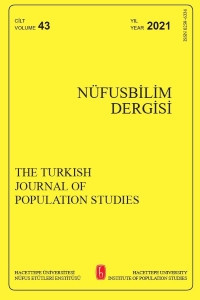TÜRKİYE’DE TEK KİŞİLİK HANEHALKLARINDAKİ ARTIŞ: TERCİHLERDEN DOLAYI MI YOKSA KOŞULLARDAN MI?
hanehalkı, tek yaşama, aile yapısı, modernizasyon
THE INCREASE IN THE PREVALENCE OF ONE-PERSON HOUSEHOLDS IN TURKEY: BY CHOICES OR BY CIRCUMSTANCES?
household, living alone, family structure, modernization,
___
- Adams, B. N. & Trost J. (2005). Handbook of World Families, Sweeden: Sage Publications
- Başlevent, C. (2021). Türkiye’nin değişen hanehalkı yapısı: Tek kişilik haneler ne durumda? [Turkey’s changing household structure: What about single person households?]. Yildiz Social Science Review, 6(1), 17-29.
- Baştuğ, S. (2003). The Household and Family in Turkey: An Historical Perspective. In Autonomy and Dependence in the Family: Turkey and Sweden in Critical Perspective. (Ed.) Liljeström, R. and Özdalga, R. Istanbul: Swedish Research Institute
- Çağatay, P. & Koç, İ. (2008). “Is Solo Living a Matter of Choice or Circumstance in Turkey”, Poster presentation at European Population Conference 2008, Barcelona, Spain, 9-12 July:359-360.
- Eisenstadt, S. N. (1966). Modernization: Protest and Change, Prentice Hall Inc., Englewood Cliffs, New Jersey, p.1
- Fricke, T. (1997). Culture Theory and Population Process: Toward a Thicker Demography, in D.I. Kertzer and T. Fricke (eds.), Anthropological Demography: Toward a New Synthesis, Chicago: University of Chicago Press, pp. 248 – 277.
- Geertz, C. (1973). The Interpretation of Cultures, New York: Basic Books.
- Gujarati, D. N. (2004) Basic Econometrics. (ed. 4th. Pp.596-599), McGraw-Hill Companies.
- Hacettepe University Institute of Population Studies (2004), Turkey Demographic and Health Survey, 2003. Hacettepe University Institute of Population Studies, Ministry of Health General Directorate of Mother and Child Health and Family Planning, State Planning Organization and European Union. Ankara, Turkey
- Hacettepe University Institute of Population Studies. (2009). Turkey Demographic and Health Survey, 2008. Hacettepe University Institute of Population Studies, Ministry of Health General Directorate of Mother and Child Health and Family Planning, T.R. Prime Ministry Undersecretary of State Planning Organization and TÜBİTAK, Ankara, Turkey.
- Hacettepe University Institute of Population Studies (2015). 2013 Turkey Demographic and Health Survey. Hacettepe University Institute of Population Studies, Republic of Turkey, Ministry of Development, Scientific and Technological Research Council of Turkey (TÜBİTAK), Ankara.
- Hacettepe University Institute of Population Studies (HUIPS) (2019). 2018 Turkey Demographic and Health Survey. Hacettepe University Institute of Population Studies, T.R. Presidency of Turkey Directorate of Strategy and Budget, Scientific and Technological Research Council of Turkey (TÜBİTAK), Ankara.
- Hacettepe University Institute of Population Studies and Macro International Inc. (1999). Turkey Demographic and Health Survey 1998, HUIPS, Ankara.
- Kağıtçıbaşı, Ç. (1982). The Changing Value of Children in Turkey, Hawaii: East-West Population Institute Publication, No. 60-E.
- Kavas, S. & Thornton, A. (2013). Adjustment and Hybridity in Turkish Family Change: Perspectives from Developmental Idealism. Journal of Family History, 38(2): 223-241.
- Koç, İ. (1997). Female-headed households in Turkey and socio-demographic and economic characteristics of female households’ heads. Nüfusbilim Dergisi, 19: 73-99.
- Koç, İ. (2019). Formation of single-parent families in the process of changing family structure in Turkey: Its determinants and welfare status (2006 2016). Research on Family Structure in Turkey-Advanced Statistical Analyses 2018 (109–155). Ankara: Republic of Turkey Ministry of Family Labour and Social Services.
- Koç, İ., Özgören, A., & Şirin, H. (2010). Türkiye’de Yaşlıların Yaşam Kalitesi ve Aile Yapısının Yaşlıların Yaşam Kalitesine Etkisi [The Quality of Life of the Elderly in Turkey and the Effect of Family Structure on the Quality of Life of the Elderly].
- 2008 Türkiye Nüfus ve Sağlık Araştırması İleri Analiz Çalışması: Türkiye’de Doğurganlık, Üreme Sağlığı ve Yaşlılık (231-283). Ankara: Hacettepe Üniversitesi Nüfus Etütleri Enstitüsü, Sağlık Bakanlığı Ana Çocuk Sağlığı ve Aile Planlaması Genel Müdürlüğü, Başbakanlık Devlet Planlama Teşkilatı Müsteşarlığı ve TÜBİTAK.
- Laslett, P. (1972). Introduction. Household and Family in Past Time (1-86), London: Cambridge University Press. Ministry of Health, Hacettepe University Institute of Population Studies, and Macro International Inc. (1994). Turkey Demographic and Health Survey 1993, HUIPS, Ankara.
- Organisation for Economic Co-operation and Development (OECD). (2011). Projections, Policy Challenges and Policy Options. The Future of Families to 2030 (7–8). doi: 10.1787/9789264168367-en.
- Ortiz-Ospina, E. (2019). The rise of living alone: how one-person households are becoming increasingly common around the world. Retrieved from https:// ourworldindata.org/living-alone, accessed on 18,04,2020.
- Steyerberg, E. W., Vickers, A. J., Cook, N. R., Gerds, T., Gonen, M., Obuchowski, N., & Kattan, M. W. (2010). Assessing the Performance of Prediction Models. Epidemiology (21(1), pp.129). doi:10.1097/ede.0b013e3181c30fb2
- Turkish Statistical Institute (TURKSTAT). (2021). Address Based Population Registration System Results: Regional Statistics, Retrieved from https://biruni.tuik.gov.tr/bolgeselistatistik/tabloOlustur.do#. Jan 20, 2023.
- Thornton, A. (2001). The Developmental Paradigm, Reading History Sideways and family change. Demography, 38, 449-465.
- Thornton A, Pierotti R. S., Young-DeMarco L., & Watkins, S. (2014). Developmental Idealism and Cultural Models of the Family in Malawi. Popul Res Policy Rev. 2014 Oct 1;33(5):693-716. doi: 10.1007/s11113-014-9322-0. PMID: 25197155; PMCID: PMC4153731.
- Yavuz, S. (2002). Household Composition and Complexity in Turkey: Findings from the Turkish Demographic and Health Survey 1998. (Unpublished Master Thesis), Ankara: Hacettepe University Institute of Population Studies.
- Yavuz, S. & Yüceşahin, M. M. (2012). Türkiye’de Hanehalkı Kompozisyonlarında Değişimler ve Bölgesel Farklılaşmalar [Changes and Regional Differences in Household Compositions in Turkey.]. Sosyoloji Araştırmaları Dergisi, 15(1): 76- 118.
- ISSN: 0259-6334
- Başlangıç: 1979
- Yayıncı: Hacettepe Üniversitesi
TÜRKİYE’DE İLLER ARASI GÖÇ İLİŞKİLERİNİN TOPOLOJİK ÖZELLİKLERİ VE KÜÇÜK DÜNYALAR ÖZELLİĞİ
Ömer BİLEN, Leyla BİLEN KAZANCIK
Düzeltme: Nüfusbilim Dergisi, Cilt 43*
Ayşe ABBASOĞLU ÖZGÖREN, Taylan ACAR
HEADSCARVES AND FERTILITY OF WOMEN IN TURKEY
Hanife ALİEFENDİOĞLU, Fatma Umut BEŞPINAR
TÜRKİYE’DE TEK KİŞİLİK HANEHALKLARINDAKİ ARTIŞ: TERCİHLERDEN DOLAYI MI YOKSA KOŞULLARDAN MI?
